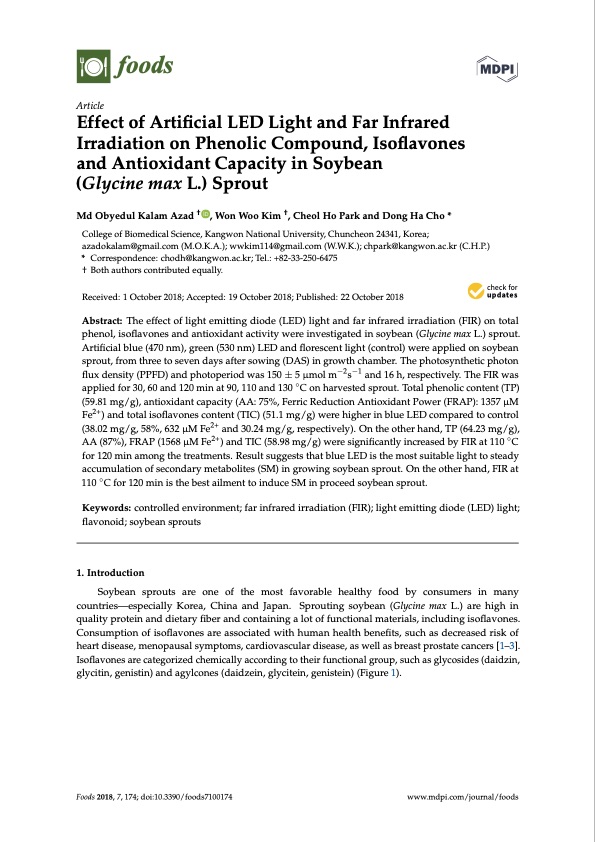
PDF Publication Title:
Text from PDF Page: 001
foods Article Effect of Artificial LED Light and Far Infrared Irradiation on Phenolic Compound, Isoflavones and Antioxidant Capacity in Soybean (Glycine max L.) Sprout Md Obyedul Kalam Azad † , Won Woo Kim †, Cheol Ho Park and Dong Ha Cho * College of Biomedical Science, Kangwon National University, Chuncheon 24341, Korea; azadokalam@gmail.com (M.O.K.A.); wwkim114@gmail.com (W.W.K.); chpark@kangwon.ac.kr (C.H.P.) * Correspondence:chodh@kangwon.ac.kr;Tel.:+82-33-250-6475 † Both authors contributed equally. Received: 1 October 2018; Accepted: 19 October 2018; Published: 22 October 2018 Abstract: The effect of light emitting diode (LED) light and far infrared irradiation (FIR) on total phenol, isoflavones and antioxidant activity were investigated in soybean (Glycine max L.) sprout. Artificial blue (470 nm), green (530 nm) LED and florescent light (control) were applied on soybean sprout, from three to seven days after sowing (DAS) in growth chamber. The photosynthetic photon flux density (PPFD) and photoperiod was 150 ± 5 μmol m−2s−1 and 16 h, respectively. The FIR was applied for 30, 60 and 120 min at 90, 110 and 130 ◦C on harvested sprout. Total phenolic content (TP) (59.81 mg/g), antioxidant capacity (AA: 75%, Ferric Reduction Antioxidant Power (FRAP): 1357 μM Fe2+) and total isoflavones content (TIC) (51.1 mg/g) were higher in blue LED compared to control (38.02 mg/g, 58%, 632 μM Fe2+ and 30.24 mg/g, respectively). On the other hand, TP (64.23 mg/g), AA (87%), FRAP (1568 μM Fe2+) and TIC (58.98 mg/g) were significantly increased by FIR at 110 ◦C for 120 min among the treatments. Result suggests that blue LED is the most suitable light to steady accumulation of secondary metabolites (SM) in growing soybean sprout. On the other hand, FIR at 110 ◦C for 120 min is the best ailment to induce SM in proceed soybean sprout. Keywords: controlled environment; far infrared irradiation (FIR); light emitting diode (LED) light; flavonoid; soybean sprouts 1. Introduction Soybean sprouts are one of the most favorable healthy food by consumers in many countries—especially Korea, China and Japan. Sprouting soybean (Glycine max L.) are high in quality protein and dietary fiber and containing a lot of functional materials, including isoflavones. Consumption of isoflavones are associated with human health benefits, such as decreased risk of heart disease, menopausal symptoms, cardiovascular disease, as well as breast prostate cancers [1–3]. Isoflavones are categorized chemically according to their functional group, such as glycosides (daidzin, glycitin, genistin) and agylcones (daidzein, glycitein, genistein) (Figure 1). Foods 2018, 7, 174; doi:10.3390/foods7100174 www.mdpi.com/journal/foodsPDF Image | Effect of Artificial LED Light and Far Infrared Irradiation on soybean

PDF Search Title:
Effect of Artificial LED Light and Far Infrared Irradiation on soybeanOriginal File Name Searched:
foods-07-00174.pdfDIY PDF Search: Google It | Yahoo | Bing
Cruise Ship Reviews | Luxury Resort | Jet | Yacht | and Travel Tech More Info
Cruising Review Topics and Articles More Info
Software based on Filemaker for the travel industry More Info
The Burgenstock Resort: Reviews on CruisingReview website... More Info
Resort Reviews: World Class resorts... More Info
The Riffelalp Resort: Reviews on CruisingReview website... More Info
| CONTACT TEL: 608-238-6001 Email: greg@cruisingreview.com | RSS | AMP |